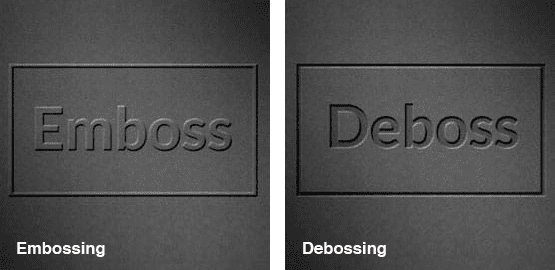Embossing and Debossing
Embossing is a printing technique that applies pressure to specific areas of paper, creating a raised shape or image. This raised area provides a tactile and visual contrast against the flatness of the rest of the sheet, resulting in a three-dimensional effect. Embossing is commonly used when a high-end, bespoke look is desired, such as for wedding stationery, letterheads, folders, certificates, packaging, and other premium printed notepads. Additionally, embossing can be used as a security feature to prevent counterfeiting.

How is embossing applied
To achieve the embossed effect, the paper is placed between two metal dies made of either magnesium or copper. The die underneath the paper contains the raised pattern or image, while the die on top of the paper (the counter die) has a recessed version of the same pattern. The two dies are then pressed together using both heat and pressure, forcing the paper into the recessed die. This action causes the paper fiber to be squeezed, creating the permanently embossed area on the paper.
Types of embossing
Blind Embossing
Blind embossing is a term used to describe the technique of creating a raised but unprinted area on the paper. This provides a noticeable but subtle contrast without the use of any ink or foil, and is able to cope with fairly small details. The process is similar to regular embossing, with the only difference being that the area being raised is left unprinted. Blind embossing is a popular option for those who want to add a subtle, yet noticeable effect to their printed notepads or other printed materials.
Registered Embossing
Registered embossing is a technique where embossing is used in conjunction with print, foil, or spot UV varnish (or a combination of more than one of these). This method ensures that the embossed area is in precise alignment with the printed, foiled, or varnished element. Additionally, a second embossed area can also be used to provide even more contrast and enhance the visual impact of the printed notepads or other printed materials. Registered embossing is a great way to add texture and depth to your designs while maintaining a cohesive and polished look.
Combination Embossing
Registered embossing is a technique where an image is printed, foiled, or applied in spot UV, and the embossing is precisely aligned to the image so that the printed element is stamped out. This method is particularly suited to text and simple images, as the raised effect helps to emphasize the printed or foiled design, adding an extra dimension of depth and texture. The result is a high-quality finish that catches the eye and elevates the visual impact of the printed notepads or other printed materials.
Debossing
Debossing is a printing technique that is exactly the same process as embossing, except that the metal dies are transposed so that the area is stamped into the paper and forms a recessed (dented) area. Just like embossing, you can have the area plain and unprinted with just the debossed effect on printed notepads, or you can fill the area with ink or foiling to enhance the visual impact of the design. Debossing is a great way to add depth and texture to your printed notepads, as well as to create a subtle and sophisticated look that is ideal for high-end stationery, invitations, and other printed materials.

Things to consider before you start
Artwork
For this process, it is recommended to use vector files as they can easily be scaled up or down without loss of quality, ensuring that the embossed area remains sharp and crisp. When creating designs for embossing, it is best to keep it simple, as the embossing is the star of the show. Avoid shading and, where possible, keep to a single color so that the embossing isn’t lost in the print. This is especially important if you plan to use combination embossing, where multiple embossed areas are used together. By keeping the design simple, you can ensure that the embossing is clearly visible and creates a strong visual impact on your printed notepads.
Choosing the embossed area
Indeed, less is best when it comes to embossing. It’s crucial to choose the right design that is appropriate for the purpose and avoid overcrowding. This is because the embossing effect will stand out more if it is used sparingly.
Choosing the pattern and Paper weight
Consider the depth of your embossing. Deep embossing isn’t suitable for small areas as the paper will be susceptible to tearing. If multi-level embossing is to be used then use the deeper levels in the less intricate areas to minimise any distress to the paper.
Your paper will need to be thick enough to accommodate the depth without being weakened so if deep embossing is to be used then a heavy paper weight is recommended. A deep emboss onto a heavy weight paper will give a deep and detailed image.
Consider the reverse
The embossing or debossing process will move the paper to the other side of the sheet so there will inevitably be a raised or recessed area on the other side of the sheet.
If you have any further questions about embossing or debossing then call us on 023 8087 8037 or email us.